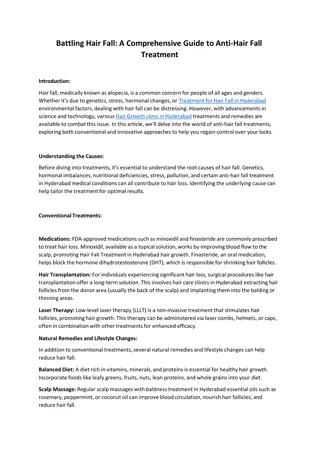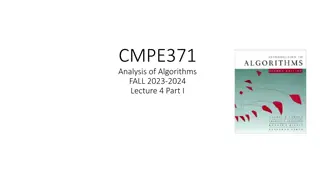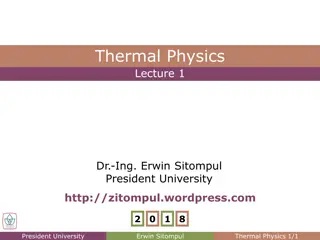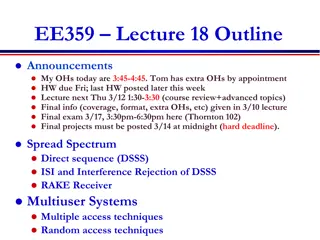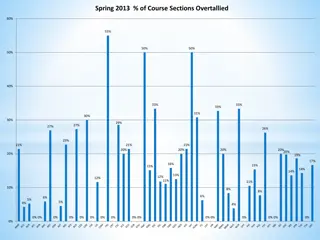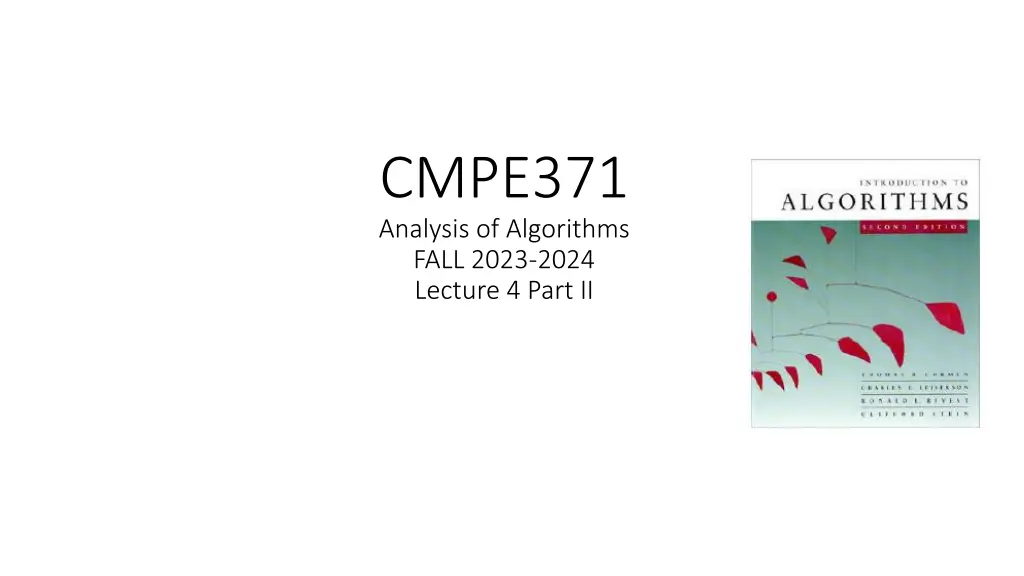
Analysis of Algorithms - Methods for Solving Recurrences
Learn about various methods for solving recurrences such as Substitution method, Iteration method, Recursion tree method, and Master method. Explore examples and techniques including guessing the solution form, verifying by induction, and solving for constants to analyze algorithms efficiently.
Download Presentation

Please find below an Image/Link to download the presentation.
The content on the website is provided AS IS for your information and personal use only. It may not be sold, licensed, or shared on other websites without obtaining consent from the author. If you encounter any issues during the download, it is possible that the publisher has removed the file from their server.
You are allowed to download the files provided on this website for personal or commercial use, subject to the condition that they are used lawfully. All files are the property of their respective owners.
The content on the website is provided AS IS for your information and personal use only. It may not be sold, licensed, or shared on other websites without obtaining consent from the author.
E N D
Presentation Transcript
CMPE371 Analysis of Algorithms FALL 2023-2024 Lecture 4 Part II
Methods for Solving Recurrences Substitution method Iteration method Recursion tree method Master method
Substitution method The most general method: 1. Guess the form of the solution. 2. Verify by induction. 3. Solve for constants. Example: T(n) = 4T(n/2) + 100n [Assume that T(1) = (1).] Guess O(n3) . (Prove O and separately.) Assume that T(k) ck3for k < n . Prove T(n) cn3by induction.
Example of substitution = + ( ) 4 ( ) 2 / T n T n 100n + 3 + 4 ( ) 2 / n c n 100n = 3 ( cn ) 2 / c 100n = 3 3 (( ) 2 / c n ) 100n desired residual desired 3 cn whenever (c/2)n3 100n 0, for example, if c 200 and n 1. residual
Example (continued) We must also handle the initial conditions, that is, ground the induction with base cases. Base: T(n) = (1) for all n < n0, where n0 is a suitable constant. For 1 n < n0, we have (1) cn3, if we pick c big enough. This bound is not tight!
A tighter upper bound? We shall prove that T(n) = O(n2). Assume that T(k) ck2for k < n: ( 4 ) ( 2 cn 2 cn = + ) 2 / + T n T n 100n 100n for no choice of c > 0. Lose!
A tighter upper bound! IDEA: Strengthen the inductive hypothesis. Subtract a low-order term. Inductive hypothesis: T(k) c1k2 c2k for k < n. ) 2 / ( 4 ) ( n c = = + T n T n 100n + 2 n ( 4 c ( ) 2 / c ( / 2 )) c n 100n 1 2 + 2 2 c n 100n 1 2 n = 2 ( c n c n ) 100n 1 2 2 2 c n c n if c2> 100. 1 2 Pick c1big enough to handle the initial conditions.
Example T(n) = T(n-1) + n Guess: T(n) = O(n2) Induction goal: T(n) c n2, for some c and n n0 Induction hypothesis: T(n-1) c(n-1)2for all k < n Proof of induction goal: T(n) = T(n-1) + n c (n-1)2+ n = cn2 (2cn c - n) cn2 if: 2cn c n 0 c n/(2n-1) c 1/(2 1/n) For n 1 2 1/n 1 any c 1 will work
Example T(n) = 2T(n/2) + n Guess: T(n) = O(nlgn) Induction goal: T(n) cn lgn, for some c and n n0 Induction hypothesis: T(n/2) cn/2 lg(n/2) Proof of induction goal: T(n) = 2T(n/2) + n 2c (n/2)lg(n/2) + n = cn lgn cn + n cn lgn if: - cn + n 0 c 1 Base case?
Changing variables T(n) = 2T( ) + lgn n Rename: m = lgn n = 2m T (2m) = 2T(2m/2) + m Rename: S(m) = T(2m) S(m) = 2S(m/2) + m S(m) = O(mlgm) (demonstrated before) T(n) = T(2m) = S(m) = O(m . lg m)=O(lg n . lglg n) Idea: transform the recurrence to one that you have seen before



